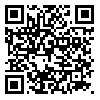Volume 27, Issue 1 (Spring 2023)
jwss 2023, 27(1): 95-112 |
Back to browse issues page
Download citation:
BibTeX | RIS | EndNote | Medlars | ProCite | Reference Manager | RefWorks
Send citation to:



BibTeX | RIS | EndNote | Medlars | ProCite | Reference Manager | RefWorks
Send citation to:
Emadi A, Fazeli S, Hooshmand M, Zamanzad-Ghavidel S, Sobhani R. Evaluation of the Effects of Morphological, Hydrological, and Land-Use Characteristics on River Water Abstraction Using Data Mining Methods. jwss 2023; 27 (1) :95-112
URL: http://jstnar.iut.ac.ir/article-1-4243-en.html
URL: http://jstnar.iut.ac.ir/article-1-4243-en.html
Sari Agricultural Sciences and Natural Resources University , emadia355@yahoo.com
Abstract: (3229 Views)
The agricultural sector as one of the most important sectors of water consumption has great importance for the sustainability of the country's water resources systems. The objective of this study was to estimate the river water abstraction (RWA) for agricultural consumption in the study area of Nobaran in the Namak Lake basin. The RWA was estimated using variables related to morphological, hydrological, and land use factors, as well as a combination of their variables collected through field sampling. Data mining methods such as adaptive-network-based fuzzy inference systems (ANFIS), group method of data handling (GMDH), radial basis function (RBF), and regression trees (Rtree) were also used to estimate the RWA variables. In the current study, the GMDH24 model with a combined scenario including the variables of river width, river depth, minimum flow, maximum flow, average flow, crop, and the garden cultivated area was adopted as the best model to estimate the RWA variable. The RMSE value for the combined scenario of the GMDH24 model was found to be 0.046 for estimating RWA in the Nobaran study area. The results showed that the performance of the GMDH24 model for estimating RWA for maximum values is very acceptable and promising. Therefore, modeling and identifying various variables that affect the optimal RWA rate for agricultural purposes fulfills the objectives of integrated water resources management (IWRM).
| Rights and permissions | |
 |
This work is licensed under a Creative Commons Attribution-NonCommercial 4.0 International License. |






